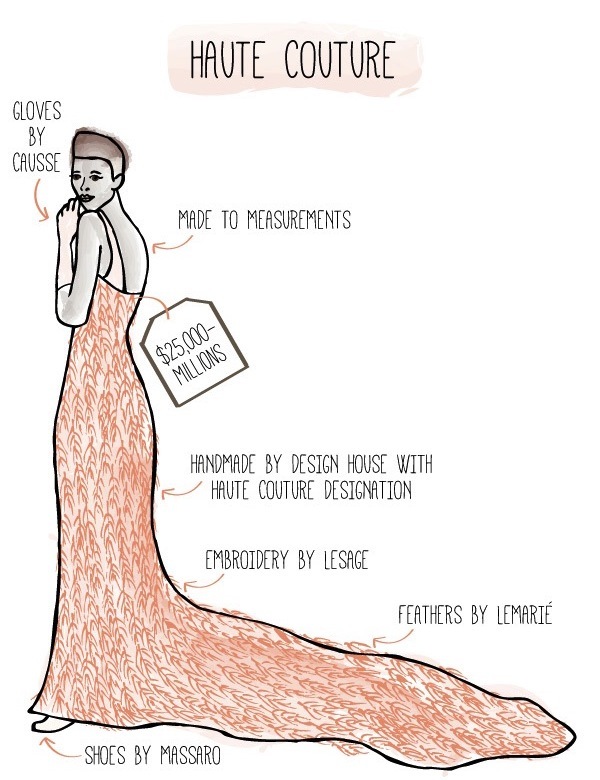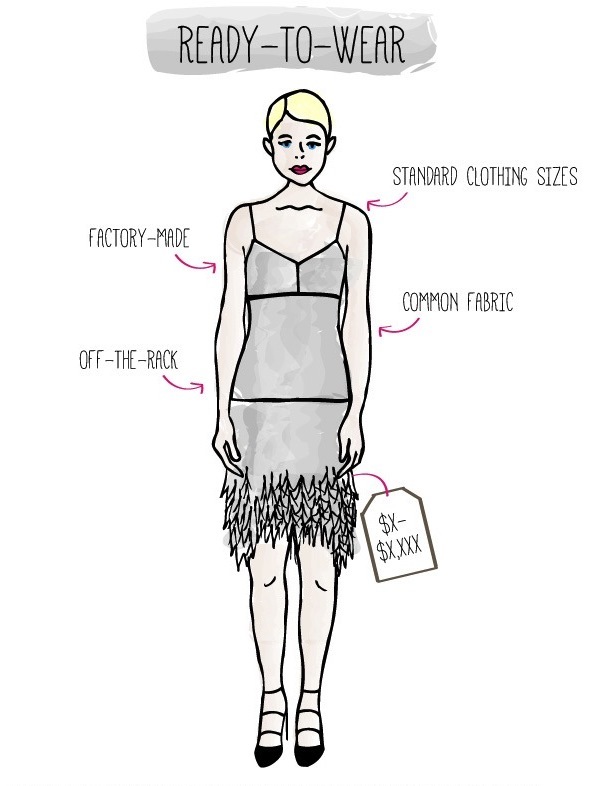
You've probably heard the phrase "haute couture" before, most likely in reference to the gowns worn at red carpet events. But what is haute couture (pronounced "oat coo-chure")? And how does it compare to the clothes noncelebrities wear, known as ready-to-wear clothes?
We've illustrated the differences between haute couture and ready-to-wear. One even requires sanction from the French Ministry of Industry. Oh là là!

Characteristics
Handmade and customized to the wearer's measurements. Haute couture translates to "high sewing" or "high dressmaking," and it's done by talented artisans.
Regulated by law. Specifically, it comes from a design house with the haute couture designation, a title granted by the French Ministry of Industry. To be eligible for this designation, a designer must create made-to-measure clothing for private clients, have a full-time workshop in Paris that employs at least 20 staffers, and present two haute couture collections of both daywear and more formal eveningwear. Those shows take place in January and July.
Can take upwards of 700 hours to make. That's partially why haute couture costs so much.
Uses the highest quality fabrics and embellishments. Another reason it costs so much.
Relies on specialized ateliers for certain aspects of an outfit. Lemarié, for instance, provides feather-and-flower creations for Chanel. And Lesage is renowned for embroidery.
Designers include: Chanel, Dior, Louis Vuitton, and Jean Paul Gaultier
Cost
Prices start at about $10,000 for daywear and go up to millions of dollars for a gown.
Clientele
In the past, 19th-centure French socialites who needed custom gowns for all of their society events wore haute couture. Now, the uber wealthy from the Middle East, Russia, and Asia make up the bulk of haute couture clientele.
Celebrities wear it too, of course, but they usually do so to promote the designer—they don't have to pay for the piece. In fact, most fashion houses don't make money off the pieces themselves, but they can be worth a lot in terms of good PR.

Characteristics
This is mainly what people buy when they shop for clothes in-store and online. Everything from these cute dresses on our site to a Burberry trench coat purchased at an upscale department store is considered ready-to-wear.
Factory-made and comes in standard clothing sizes. So when you talk about how you're a size 10, you're referring to ready-to-wear clothing. Any necessary tailoring happens to a finished garment.
Fashion designers use patterns to create these clothes. Because more of them can be sold to the masses, ready-to-wear is how designers make a profit.
Cost
Prices range the gamut, from a $12.99 blouse to an $8,400 Oscar de la Renta ball gown.
Clientele
Everyone!

Characteristics
Not quite haute couture, not quite ready-to-wear. It's something in-between.
Designer clothes with hefty price tags, but they don't require fittings and are sold off-the-rack through high-end retailers such as Net-a-Porter.
Typically requires a lot of time and effort to create. For instance, this illustration was modeled after designer Mary Katrantzou's Jewel Tree Dress, which was inspired by a Fabergé egg. The $14,200 creation was a mix of velvet, padded crinoline, crystals, and appliqued enameled roses. It took four studios more than 150 hours to make and reportedly made one seamstress cry because it was so frustrating to stitch together.
Cost
Price tags are usually in the four- and five-figure range.
Clientele
Celebrities and wealthy fashionistas
Illustrations by Jessica Snively.

RELATED READS:












